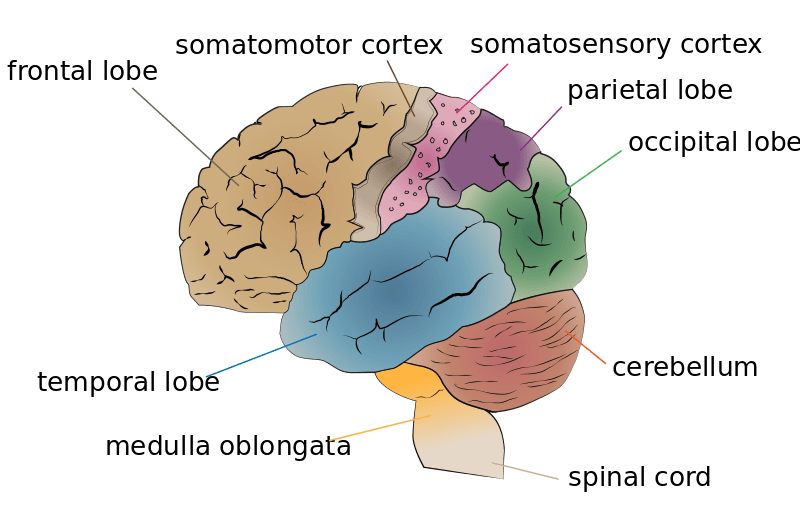Key Difference – Paresis vs Paralysis
Though, both paresis and paralysis refer to muscle weakness there is a difference between these two terms depending on the usage. ‘Paresis’ usually refers to situations where the muscles weakness is partial whereas ‘Paralysis’ is used to refer to situations where the muscle weakness is more severe or complete. This is the key difference between Paresis and paralysis. Let’s get this point cleared by understanding some basic facts used neuromuscular physiology.
The motor cortex is the region of the cerebral cortex involved in the planning, control, and execution of voluntary movements. The motor cortex is connected with muscles via nerve pathways or neurons. Muscles tone and the contraction are dependent on the integrity of this neuronal pathways. There are intermediate centers specially situated in the spinal cord which coordinate muscle contraction. Nerve trunks which connect motor cortex with the intermediate centers in the spinal cord are called upper motor neurons. Nerve trunks which connect intermediate centers with the muscles are called lower motor neurons.
What is Paresis?
Any damage to upper motor neurons results in increased tone and partial weakness of the muscles which is called paresis. One good example is stroke where people get hemiparesis or partial weakness in one side of the body. Paresis is described with the muscle, region or the organ affected. Here are some examples where the term ‘paresis’ is commonly used.
- Monoparesis — One leg or one arm is weakened
- Paraparesis — Both legs are weakened usually occurs in spinal cord damage at the lower level.
- Hemiparesis — One arm and one leg on either side of the body are weakened, this commonly occurs in strokes affecting the upper motor neurons
- Tetraparesis/Quadriparesis — All four limbs are weakened due to cervical cord or spinal cord damage at a higher level.
Muscle power is assessed by the Medical Research Council (MRC) muscle-grading scale as below.
Medical Research Council (MRC) muscle-grading scale
MRC grade of muscle strength
- 0 – No movement
- 1 – Flicker of movement only
- 2 – Movement possible, when assisted by gravity or gravity, is eliminated
- 3 – Movement possible against gravity but without imposed resistance
- 4 – Weak movement possible against gravity
- 5 – Normal movement against gravity and against imposed resistance
In paralysis, muscle strength will be 0 to 1. However, in paresis muscle strength grading will be higher than that.
What is Paralysis?
Damage to lower motor neurons results in complete paralysis of the muscle. One example is motor neuropathy which causes degeneration of the lower motor neurons. In this condition, muscle tone is greatly reduced, and the contractions are completely lost and the affected muscle becomes flaccid.
Paralysis is the complete loss of muscle function for one or more muscles. However, the term paralysis is sometimes used even to refer to partial weakness or upper motor neuron type weakness. However, if properly used, paresis is slightly different to paralysis based on the grade and the type of the weakness.

A child with infantile paralysis
What is the difference between Paresis and Paralysis?
Definition of Paresis and Paralysis
Paresis: Paresis can be defined as Partial or incomplete paralysis.
Paralysis: Paralysis can be defined as complete loss of strength in an affected limb or muscle group.
Characteristics of Paresis and Paralysis
Origin of the weakness
Paresis: Paresis or partial weakness is common with upper motor neuron type weakness affecting the higher nerve pathways.
Paralysis: Paralysis or more complete severe weakness occurs in lower motor neuron type lesions affecting lower nerve pathways.
Muscle-grading scale
Paralysis: In paralysis, grade of the weakness is very low in most of the times.
Paresis: In paresis, grade of the weakness is comparatively higher.
Muscle tone
Paresis: In paresis, muscle tone may be preserved or increased.
Paralysis: In paralysis, muscle tone is reduced in most of the times.
Distribution
Paresis: Paresis usually affects larger muscle groups.
Paralysis: Paralysis is more localized and affects well-defined muscle or muscles.
Disability level
Paresis: In paresis, disability is greater than the apparent weakness.
Paralysis: In paralysis, weakness correlates with the disability level.
Image courtesy: “Cerebrum lobes” by vectorized by Jkwchui – http://training.seer.cancer.gov/module_anatomy/unit5_3_nerve_org1_cns.html. (CC BY-SA 3.0) via Wikimedia Commons “Child with infantile paralysis walking on hands and feet (rbm-QP301M8-1887-539a~9)” by Muybridge, Eadweard, 1830-1904 – http://digitallibrary.usc.edu/cdm/ref/collection/p15799coll58/id/20442 (Public Domain) via Wikimedia CommonsncG1vNJzZmivp6x7pbXFn5yrnZ6YsqOx07CcnqZemLyue8OinZ%2Bdopq7pLGMm5ytr5Wau268wKucrKGjYq6vsIyvqmaokaeurcXSoqpo